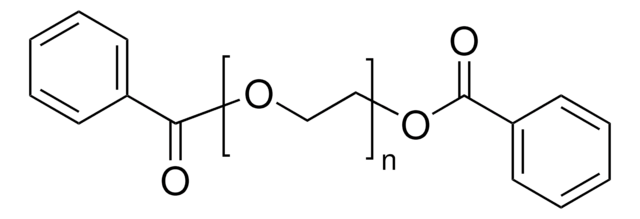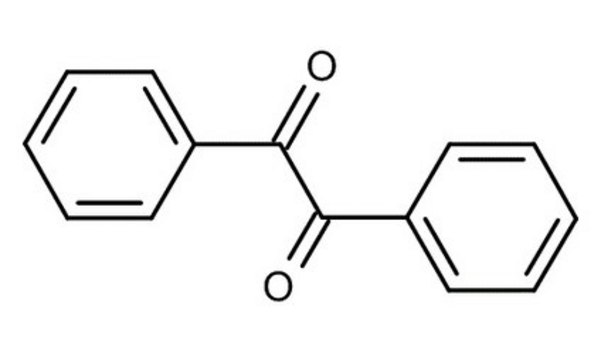369365
Di(ethylene glycol) dibenzoate
90%
Synonym(s):
2-[2-(Benzoyloxy)ethoxy]ethyl benzoate
Sign Into View Organizational & Contract Pricing
All Photos(1)
About This Item
Linear Formula:
(C6H5CO2CH2CH2)2O
CAS Number:
Molecular Weight:
314.33
EC Number:
MDL number:
UNSPSC Code:
12162002
PubChem Substance ID:
Recommended Products
Quality Level
Assay
90%
form
viscous liquid
refractive index
n20/D 1.544 (lit.)
bp
235-237 °C/7 mmHg (lit.)
density
1.175 g/mL at 25 °C (lit.)
SMILES string
O=C(OCCOCCOC(=O)c1ccccc1)c2ccccc2
InChI
1S/C18H18O5/c19-17(15-7-3-1-4-8-15)22-13-11-21-12-14-23-18(20)16-9-5-2-6-10-16/h1-10H,11-14H2
InChI key
NXQMCAOPTPLPRL-UHFFFAOYSA-N
Looking for similar products? Visit Product Comparison Guide
General description
Di(ethylene glycol) dibenzoate (DEGDB) is a widely used dibenzoate ester based plasticizer, which has either linkages at the center that connect the two benzoate groups.
Application
DEGDB can be used as a plasticizer in the fabrication of carbon black composite based sensors, which are used for the detection of electronic noise systems. It may be homogenized with poly(vinyl fluoride) and polysulfone based composite to prepare an electrolyte for lithium ion batteries.
Storage Class Code
10 - Combustible liquids
WGK
WGK 2
Flash Point(F)
235.4 °F - closed cup
Flash Point(C)
113 °C - closed cup
Personal Protective Equipment
dust mask type N95 (US), Eyeshields, Gloves
Choose from one of the most recent versions:
Already Own This Product?
Find documentation for the products that you have recently purchased in the Document Library.
Evaluation of the limit-of-detection capability of carbon black-polymer composite sensors for volatile breath biomarkers.
Kang NK, et al.
Sensors and Actuators B, Chemical, 147(1), 55-60 (2010)
Portable electronic nose system based on the carbon black-polymer composite sensor array.
Kim YS, et al.
Sensors and Actuators B, Chemical, 108(1-2), 285-291 (2005)
Preparation and performance of polymer electrolyte based on poly (vinylidene fluoride)/polysulfone blend membrane via thermally induced phase separation process for lithium ion battery.
Cheng Q, et al.
Journal of Power Sources, 266(1-2), 401-413 (2014)
Applied plastics engineering handbook: processing and materials. (2011)
Syung Hun Han et al.
ACS applied materials & interfaces, 12(3), 3936-3944 (2020-01-09)
Droplet microfluidics has enabled a significant reduction in reaction volume and analysis time, which in turn has led to transformative advances in high-capacity screening and assays. By arranging droplets into a static array, it is possible to monitor dynamic events
Our team of scientists has experience in all areas of research including Life Science, Material Science, Chemical Synthesis, Chromatography, Analytical and many others.
Contact Technical Service








